Physical Geography Exam 4
1/53
There's no tags or description
Looks like no tags are added yet.
Name | Mastery | Learn | Test | Matching | Spaced |
|---|
No study sessions yet.
54 Terms
Alfred Wegener
he found out that continents seem fixed today, but coastlines fit together, Pangea.
Alfred Wegener could not provide a convincing mechanism for how continents moved
Why was the theory of continental drift rejected?
Evidence for the current scientific theory of Plate Tectonics
Midocean ridges, Paleomagnetism, and Seafloor spreading
Internal heat → upwelling of magma/convection currents and Active plate boundaries
What drives plate tectonics?
Acrreted Terrane
grow by accumulation, pieces of lithosphere collide/fuse with another are blocks of continental fragments and oceanic islands that have collided with a continent at a convergent plate boundary and are now permanently attached.
Hot spot
40-60 around world, Hawaiian islands, don’t know format
Mantle Plumes
localized hot spots are not associated with plate boundaries
Transform boundaries
slip slide, can snag, can create earthquakes, plates laterally slip past each other, EQ’s are shallow but powerful, San Andreas Fault

Divergent boundaries
line upwelling magma, where 2 plates spread apart, shallow focus EQ’s and volcanic ranges, like finger nails growing, Iceland ridge on boundary of North American and Eurasian plate
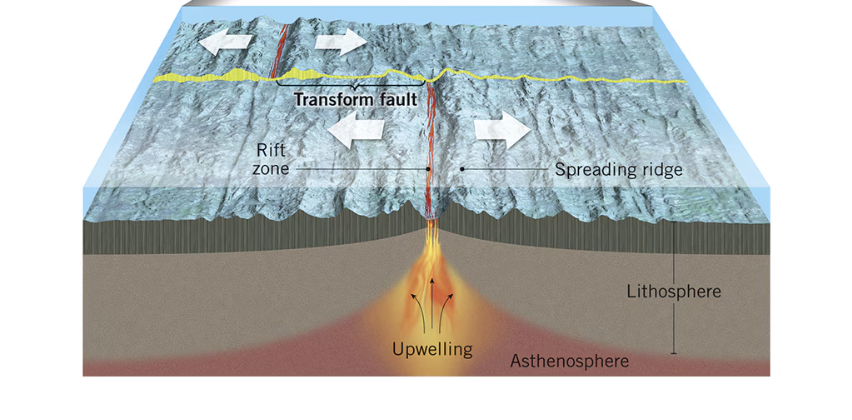
Convergent crustal boundaries
ocean-continent, ocean-ocean, and continent-continent
Ocean-Continent convergent boundary
continental rock is less dense, trenches and mountains, deep powerful EQ’s, subduction, West coast of South America Andes mountains. Cascades- Mt. St. Helens, Mt. Rainer
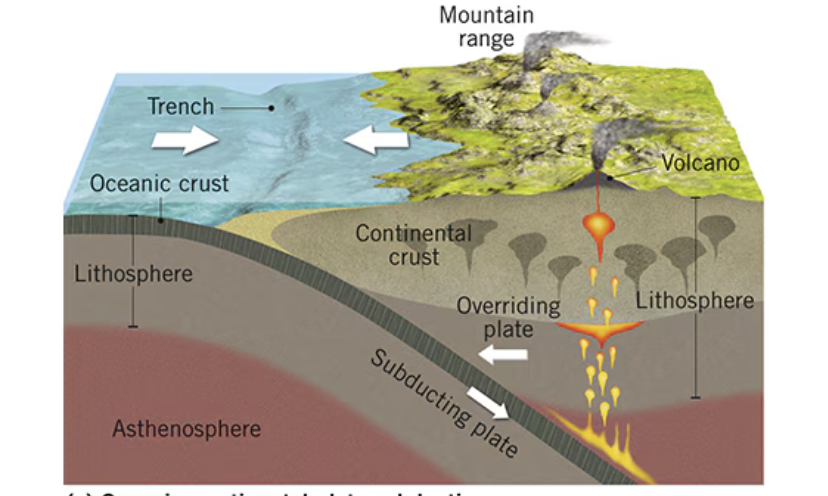
Ocean-Ocean convergent boundary
denser ocean plate subducts, trenches and island arcs, both deep and shallow EQ’s, aleutian arc off Alaska, volcanic arc of the pacific, Japan and west edge of asia
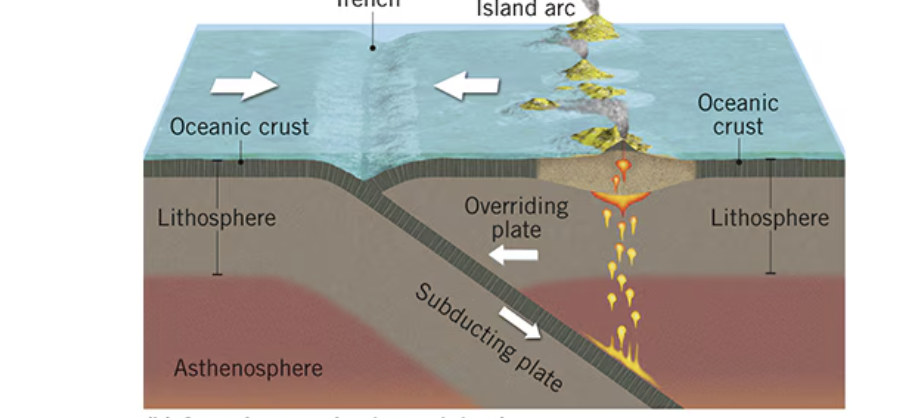
Continent-Continent convergent boundary
suturing, crusts too buoyant to subduct, shallow EQ’s are common, Himalaysan mountains
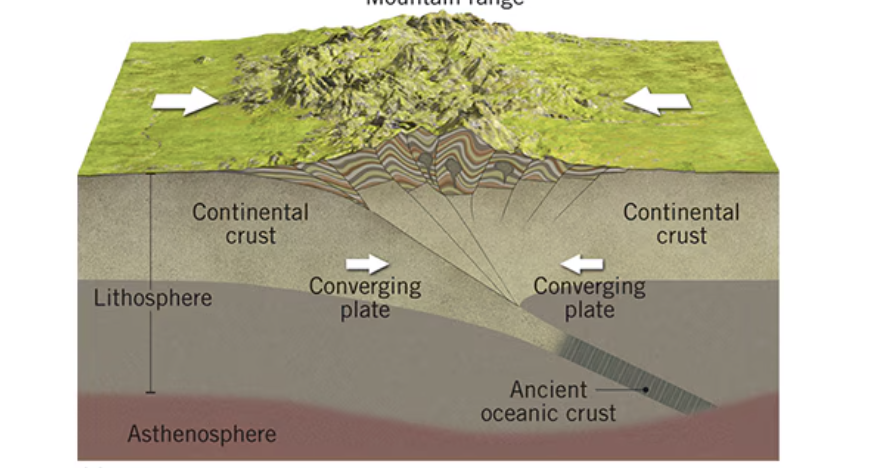
Subduction
recycling of crust material

Pacific Ring of fire
volcanoes and earthquakes help form new landforms, it surrounds the pacific ocean
Along tectonic plate boundaries, forming belts like the Pacific Ring of Fire, and at hotspots in the middle of plates. At convergent boundaries, one plate subducts under another, causing rock to melt and form volcanoes
Where are volcanoes distributed on Earth’s surface, and why at those places?
Magma chemistry and Confining Pressure
Volcanic activity is determined by _____ _____ and ______ ______
Felsic and Mafic magma
Volcanoes are classed by styles of eruption and quantity of silica matters
Felsic/High silica magma
-rich in feldspar and silica (quartz); silicate minerals (SiO2) are 95% of crust
-The most common rock is granite, typical of Earth’s crust
-Magma heavy in silica will tend to clog volcanic neck, produce violent eruptions
-lower density
-compared to peanut putter
Mafic/Low silica magma
-rich in magnesium and iron
-Common rocks include gabbro and basalt, typical of the ocean crust
-magmas are less viscous, flow more evenly, less explosiveness, builds layers
-higher density
-compared to syrup
Shield volcanoes
layers of thin lava, less pyroclastic material
Flood basalt
-a vast outpouring of smoothly flowing lava, often accompany mass extinctions, more lava comes out of these than all of the other volcanoes combined, Colombia Plateau
-large-scale outpourings of basaltic lava covering an extensive area of Earth’s surface.
extrusive igneous features: e.g., Siberian Traps, Deccan Traps
Composite volcano
higher silica lavas, alternative layers, steep slopes

Calderas
crater lake, Oregon is a collapsed volcano
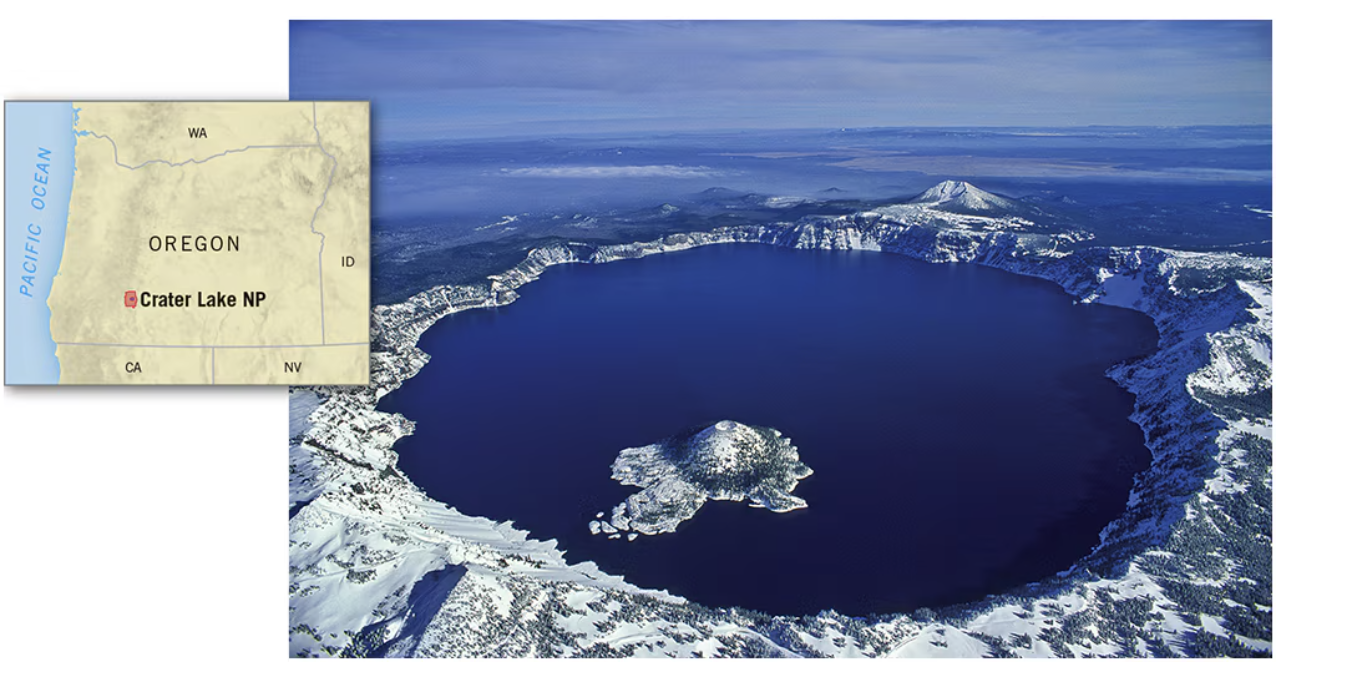
Igneous intrusions
molten rock disintegrates crust, plutons cause stoping
Lava dome volcanoes
have masses of very viscous lava, such as high-silica rhyolite, that are too thick and pasty to flow very far. Instead, lava bulges up from the vent, and the dome grows largely by expansion from below
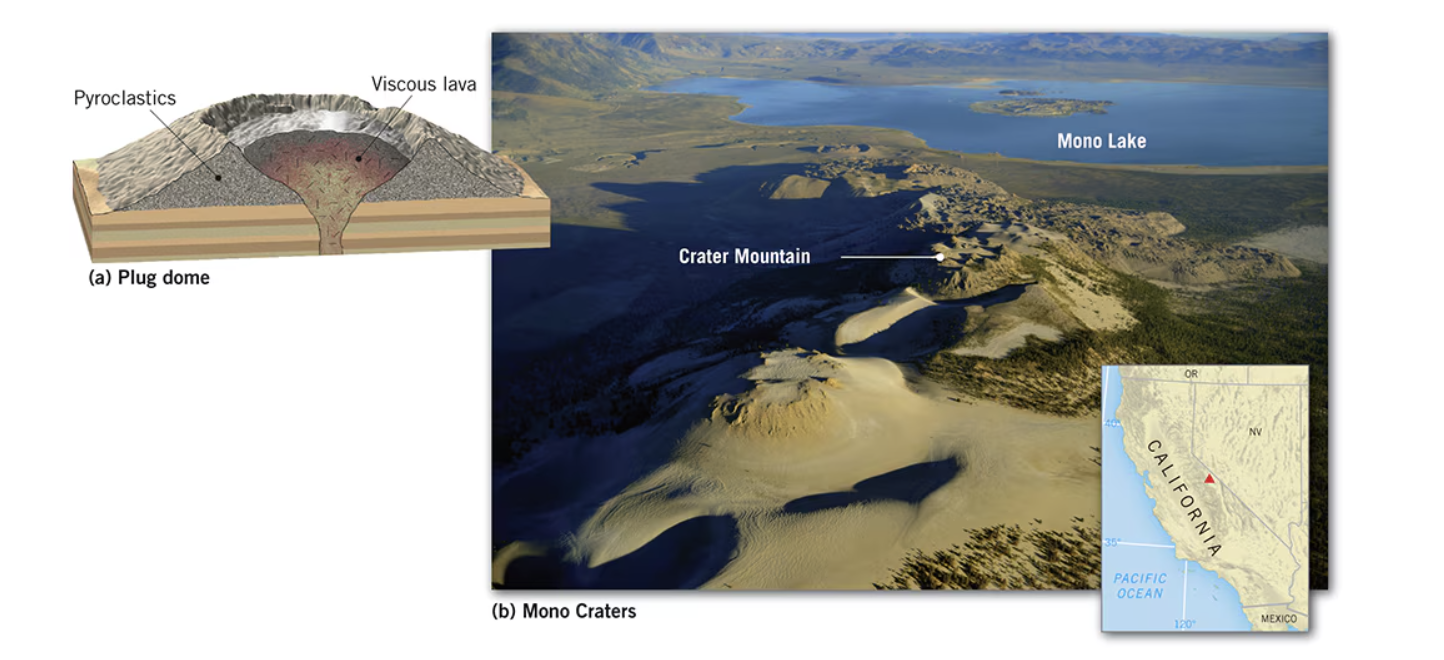
Cinder cone volcanoes
the smallest of the volcanic peaks. Their magma chemistry varies, but basaltic magma is most common. They are cone-shaped peaks built by the unconsolidated pyroclastics that are ejected from the volcanic vent
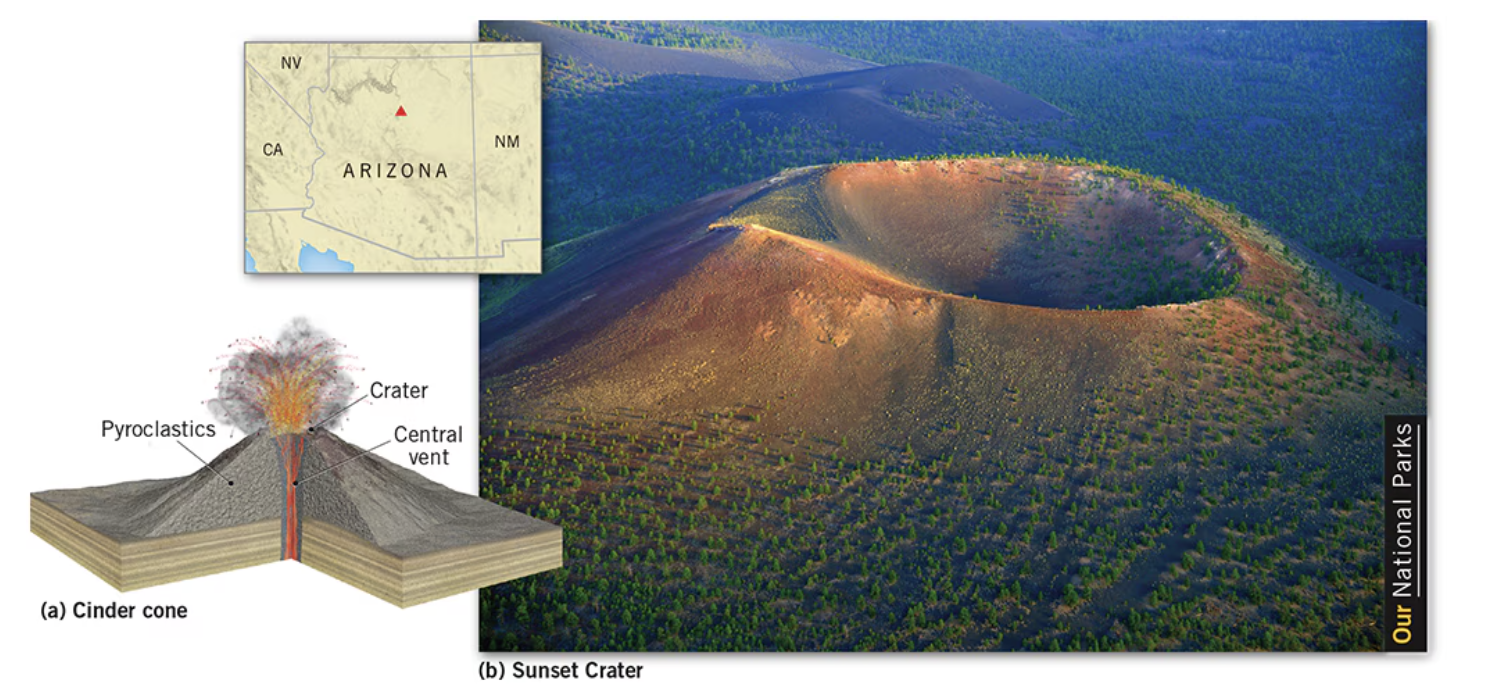
Plutons
-large bodies of igneous magma that cool/harden underground, revealed later by erosion.
-intrusive igneous features: e.g., Batholiths, Volcanic Necks, Laccoliths, Sills, Dikes
Batholith
large igneous intrusion can deform surface, half dome

Dike
vertical sheet of magma thrust up into pre-extisting rock, erosion leaves long and narrow ridge

Folding
-Appalachians created by colliding, compressing boundary; sedimentary rock layers were warped.
-lateral compression, when two forces act towards each other from opp. sides, rock layers bend into folds
Faulting
-Sierra Nevada are a classic fault-block mountain thrust upward.
-rock breaks and moves along zones of weakness in the crust begins as sudden
-earthquakes hasten their spreading
Horst
a block pushed upward (relative to blocks on either side) by faulting
Graben
a block that has been lowered relative to the blocks on either side due to faulting.
Joint
fracturing along which no movement has taken place, there are many more joints than faults in crust
Weathering and mass wasting are often called “preliminaries to erosion.” Why?
they break down and transport rock and soil, providing the material that erosion then carries away.
Denudation
disintegration, wearing away, and removal of rock material
They act as pathways for weathering agents to penetrate the rock, significantly increasing the rock's surface area and accelerating the breakdown process
Why are rock openings/jointing important in weathering?
Weathering
destroys exposed bedrock, breaks it into smaller fractions, depends on rock openings
Types of rock openings
joints, faults, lava vesicles, and solution cavities
Mechanical weathering
-frost wedging, salt wedging, temperature changes, exfoliation
-physical disintegration of rock without changes to its chemical composition
-frost wedging/shattering and salt wedging
Chemical weathering
-oxidation, hydrolysis, carbonation (‘rotting’ is most common in humid areas)
-decomposition of rock material through chemical alteration of minerals
-Oxidation, Hydrolysis, and Carbonation
Biological weathering
-plants and animals
-juniper pine took root in a limestone chunk
-lichens on rock surface
Soil, sand, regolith, and rock move downslope
typically as a mass, largely under the force of gravity, but frequently affected by water.
After rock weathers in place [in situ], what happens then?
Mass Wasting influences
Angle of repose (slope steepness), available water/soil moisture, amount of clay, earthquakes
Mass wasting
weathered material moved by gravity (Grand Canyon)
Speed and Moisture content
Mass wasting is classified by ______ and _____ ______
Fall
-rock moving through air via gravity (evidenced by talus deposit at base of cliff)
-pure gravity, talus cone
Slide
-sudden detaching of rock from steep slope, still in contact with slope
-slope may collapse even without soil being saturated
Slump
-rotational slip of solid mass of earth material lubricated by water
Flow
earthflow (wet, fine-grained material) and mudflow (wetter, faster moving
Creep
tilted fences posts or leaning headstones. Solifluction: freeze-thaw cycle in Tundra
Exfoliation
“unlocking” can happen after erosion exposes an exfoliation dome, Yosemite
Rain and Heat
Average depth of weathering is greatest near equator because of ______ and ______